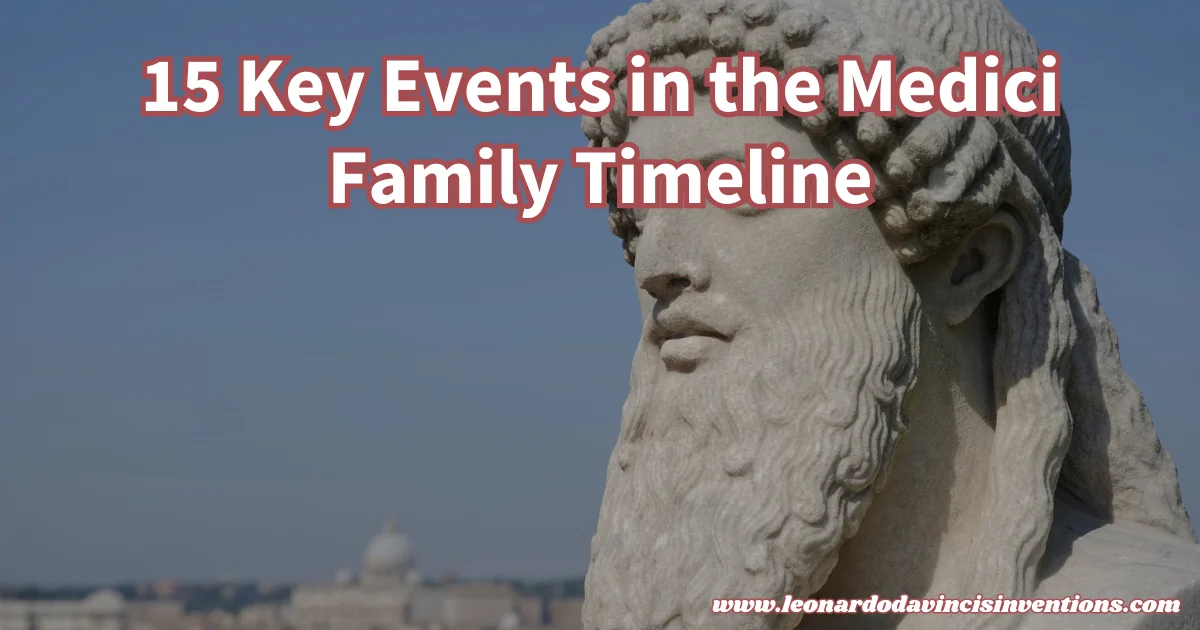
The Medici family timeline can be complex due to its extensive history and numerous significant figures involved.
Many struggle to identify which events have shaped the family’s power and legacy. This article will help by highlighting 15 key events and providing a clear overview of the most significant moments.
Learning about the most significant moments in the Medici family timeline gives readers a deeper understanding of how the Medici family ruled Florence and shaped history.
These selected events provide a straightforward way to observe the rise and influence of one of Europe’s most powerful families.
1. Founding of the Medici Bank by Giovanni di Bicci de’ Medici in 1397
The founding of the Medici Bank in 1397 marked a turning point in the Medici family timeline. Giovanni di Bicci de’ Medici relocated the bank’s headquarters to Florence, laying the groundwork for the rise of a prominent banking family in Italy.
Giovanni expanded the Medici Bank into one of Europe’s most respected financial institutions by capitalizing on Florence’s economic growth. The wealth from the bank enabled the Medici family to gain political influence and solidify their position as rulers of Florence.
This move allowed the Medici to become key players in the Italian Renaissance. Their financial success enabled them to support art, culture, and architecture throughout Tuscany and beyond.
Giovanni’s decision set the foundation for the Medici’s future power and long-lasting impact on European history.
2. Cosimo de’ Medici rises to power in Florence in 1434
Cosimo de’ Medici became a central figure in the Medici family timeline when he gained control of Florence in 1434. This event marked the beginning of the Medici political dynasty and laid the groundwork for the family’s future influence during the Renaissance.
Cosimo led the powerful House of Medici, a well-known banking family in Italy. Through his extensive banking network, he amassed vast wealth, which enabled him to gain support among Florence’s elite.
He managed politics and finance, shaping the city’s government behind the scenes. Under Cosimo’s rule, Florence thrived as a republic, but he held the real power without having a royal title.
Cosimo became the unofficial ruler of Florence, quietly guiding its politics while maintaining the appearance of traditional governance. His patronage of the arts also began during this period, laying the groundwork for the Medici legacy in culture and the Italian Renaissance.
His success made the Medici family one of the most influential families in Tuscany and Italy for generations.
3. Construction of the Basilica of Santa Croce was completed
The construction of the Basilica of Santa Croce in Florence is pivotal in both the Medici family’s timeline and the city’s history. Built for the Franciscan order, this church began to take shape in 1294 under Arnolfo di Cambio, a famous architect of the era.
It quickly became an important landmark for the growing influence of the Medici family in Tuscany. As rulers of Florence and a powerful banking family, the Medici played a significant role in shaping the arts and culture of the Italian Renaissance.
Santa Croce became the burial place for many of Florence’s great figures, including Michelangelo, who had close ties with the Medici family. The basilica reflects the Medici legacy of art sponsorship and patronage that helped define the Renaissance.
Major Medici members contributed to its decoration and upkeep, making it a lasting symbol of their impact on Florence. Santa Croce’s history and significance are closely linked to the Medici commitment to religious, cultural, and artistic projects.
4. The Medici family begins major patronage of Renaissance arts in the mid-15th century
The Medici family started their significant patronage of the arts in Florence during the mid-15th century. Cosimo de’ Medici, known as Cosimo the Elder, used his family’s banking wealth to support artists, architects, and scholars.
This support helped Florence become a center for art and learning in Italy. Cosimo’s generosity attracted top talent, leading to patronage of the arts that defined the city’s culture.
The Medici family sponsored artists such as Donatello and Fra Angelico. Later generations continued this tradition.
The House of Medici also shaped architecture. They funded the construction of iconic buildings, like the Medici Palace.
Their role as rulers of Florence enabled them to utilize art to demonstrate power and stability. This dynasty’s focus on cultural achievements marked a turning point in the Medici family’s timeline.
Their support laid the groundwork for later artists, including Michelangelo and Leonardo da Vinci, who still shape the legacy of the Medici’s contributions to art in history.
5. Lorenzo de’ Medici, ‘the Magnificent’, leads Florence during its cultural peak
Lorenzo de’ Medici, also known as “the Magnificent,” was at the center of the Medici family’s timeline in the 15th century. He guided Florence through its golden age, supporting significant advancements in art, culture, and intellectual life.
Lorenzo led the House of Medici with both political influence and patronage of the arts. Under his rule, Florence saw artists like Michelangelo and Leonardo da Vinci thrive.
The Medici family gained wealth through banking and solidified their power as rulers of Florence. Lorenzo’s leadership fostered stability and encouraged cultural achievements that shaped the city’s legacy.
He strengthened alliances with other powerful families and promoted peace with neighboring states. Lorenzo left a deep mark on Florence and the broader world by supporting scholars, poets, and architects.
6. Pazzi Conspiracy against the Medici family in 1478
The Pazzi Conspiracy against the Medici family happened in Florence in 1478. This event became one of the most famous assassination attempts in the history of the Italian Renaissance.
The Medici family, a powerful banking dynasty and major patrons of the arts, faced a deadly threat that could have changed the Medici family timeline forever. On April 26, 1478, the conspiracy unfolded during Easter mass at the Cathedral of Florence.
Plotters tried to kill both Lorenzo de’ Medici (Lorenzo the Magnificent) and his brother Giuliano de’ Medici. Lorenzo survived with wounds, but Giuliano lost his life in the attack.
Powerful rivals and some members of the nobility took part in this plot, hoping to end Medici rule over Florence. The Pazzi family planned this attack with support from outside allies, including clergy connected to the Papacy.
They aimed to seize political power and diminish the Medici’s influence on Florence’s government and wealth. After the failed assassination, violent retaliation swept through Florence.
The government captured and punished the conspirators. The incident solidified Lorenzo de’ Medici’s position as the leading figure in Florence, expanding the House of Medici’s legacy and enhancing their influence on the Renaissance.
7. Establishment of Medici control over Florence’s government
The Medici family rose to power in the early 15th century through skillful banking and political alliances in Florence. Cosimo de’ Medici, known as Cosimo the Elder, used his wealth and connections to influence the government, even though he did not hold any official title.
Cosimo’s careful use of patronage allowed him to become the unofficial ruler of Florence. He supported key artists and citizens, which helped him gain loyalty and respect in the city.
By placing allies in important offices, he shaped the direction of Florentine Politics. This marked the start of the House of Medici’s dominance as a political dynasty in Tuscany.
Their influence made them central figures in the Italian Renaissance, guiding the city through conflict and cultural achievement. Medici control did not come from force; instead, it relied on the family’s ability to blend wealth, strategy, and reputation.
The Medici family’s impact on Florence’s government is evident throughout the Medici family timeline. Their methods changed the way power worked in the Republic of Florence.
8. Election of Giovanni de’ Medici as Pope Leo X in 1513
The election of Giovanni de’ Medici as Pope Leo X in 1513 marks a significant turning point in the Medici family’s timeline. At just 37 years old, Giovanni took the papacy, showing the family’s incredible reach in politics and religion.
His rise to power further solidified the dynasty’s connection to the Catholic Church. It gave the rulers of Florence a new level of influence on the Renaissance and European politics.
As Pope, Leo X used the family’s banking wealth to support art, culture, and major building projects in Rome. The Medici popes, including Leo X, significantly influenced the church and played pivotal roles in the era’s complex politics.
His election marked another step in the Medici family’s long tradition of patronage and leadership that helped define the Italian Renaissance.
9. Acquisition of the hereditary title Duke of Florence in 1532
The Medici family secured a significant position in the political dynasty of Florence in 1532. This year marked when the House of Medici earned the hereditary title of Duke of Florence.
This change transformed their influence from unofficial rulers to recognized nobility within Italy. The Pope, Clement VII, a Medici, used his authority to appoint Alessandro de’ Medici as the first Duke.
This shift marked the end of the Florentine Republic and ushered in a new era of Medici succession. With this title, the Medici became Dukes, strengthening their legacy in Tuscany.
The family’s wealth from banking and involvement in Renaissance arts now went hand in hand with formal power over Florence’s government. Recognition as dukes allowed the Medici to increase their patronage of the arts.
This furthered Florence’s reputation as a center for cultural achievements. The Medici’s role as rulers of Florence was now secure, granting them more authority and setting the stage for the establishment of the Grand Duchy of Tuscany.
10. Cosimo I de’ Medici becomes Duke of Florence in 1537
Cosimo I de’ Medici became Duke of Florence in 1537 at the age of 17. His rise followed the assassination of Alessandro de’ Medici, which triggered a major shift in the Medici family’s timeline and the city’s politics.
Cosimo I was not immediately seen as a strong contender for this position. Many nobles thought they could easily control him due to his youth and inexperience.
Cosimo quickly proved himself to be a determined leader. Under Cosimo’s rule, the House of Medici expanded its power beyond Florence.
He centralized authority and reduced the influence of rival nobles. Cosimo’s government helped turn Florence into a strong Duchy within Tuscany.
Cosimo’s rule marked a new era in the Italian Renaissance. He increased Medici patronage of the arts and started many building projects.
His time as Duke was crucial to the Medici legacy, expanding their influence in local and European politics.
11. Elevation of Florence to the Grand Duchy of Tuscany in 1569
The year 1569 marked a major turning point in the Medici family timeline. Cosimo I de’ Medici, one of the most notable rulers of Florence, achieved the title of Grand Duke.
This title change elevated Florence to the Grand Duchy of Tuscany, making it an important state in Italy. This move strengthened the political dynasty of the House of Medici.
The elevation gave the family even more power and recognition among European nobility. It cemented their role as rulers over a much larger territory, extending their influence throughout Tuscany.
The creation of the Grand Duchy highlighted the Medici’s legacy of wealth, political skill, and patronage of the arts. Although their rise to power had begun in banking, it was their political achievements that solidified their status as grand dukes.
The Medici continued to shape the culture and politics of Renaissance Italy well into the late 16th century. This event also marked a shift from Florence as a republic to a hereditary monarchy under the Medici family.
This change further solidified their long-standing influence on Italian history and the region’s development.
12. Cosimo I is named the first Grand Duke of Tuscany by the Pope
Cosimo I took an important step in the Medici family timeline when the Pope named him the first Grand Duke of Tuscany. This happened in 1569, marking a new chapter for the House of Medici and their influence in Italy.
Until then, Cosimo held the title of Duke of Florence. The Papacy’s decision enhanced the family’s authority and solidified their status among the European nobility.
The Medici dynasty gained more power over Tuscany, not just Florence, by receiving this new title. The change also demonstrated the close relationship between the Medici rulers and the Catholic Church, strengthening their political position.
This event marked a key shift from the old Republic of Florence to a hereditary and more centralized rule led by the Medici. The family’s reach expanded, and their role as major players in Renaissance politics became even clearer.
Cosimo’s new title demonstrated the Medici legacy as rulers who shaped the history and culture of Tuscany during the 16th century.
13. Expansion of Medici territorial holdings in Tuscany during the late 16th century
The Medici family expanded their territorial holdings in Tuscany during the late 16th century. This period marked a turning point in the Medici family’s timeline, as they transitioned from local rulers of Florence to controlling most of Tuscany.
As Grand Dukes of Tuscany, the Medici gained new lands through political agreements and military actions. Cosimo I de’ Medici led many of these efforts, expanding their rule to include cities like Siena.
Their success solidified the Medici legacy as one of Italy’s most powerful dynasties. The Medici family’s growing influence in Tuscany increased their regional wealth and power.
Their rule brought stability, which supported economic growth and the arts. As rulers of Florence and the broader territory, the Medici significantly influenced politics and daily life in Renaissance Italy.
During this time, the Medici dynasty strengthened cultural achievements by sponsoring artists and architects. Their expansion in Tuscany helped the House of Medici become a symbol of nobility and influence.
This left a lasting effect on Italian history.
14. Catherine de’ Medici marries into French royalty, becoming Queen of France
Catherine de’ Medici, a key member of the Medici family, played a vital role in the family’s timeline. She was born in Florence, at the heart of the Italian Renaissance.
The Medici family had established itself as a powerful political dynasty and banking family in Tuscany. In 1533, Catherine married Henry, Duke of Orleans, who later became King Henry II of France.
This marriage was not just personal but also a major political alliance. It strengthened ties between the House of Medici and the French monarchy, further expanding Medici influence beyond Italy.
When Henry II became king in 1547, Catherine became Queen of France. As queen, she held significant power and was a central figure in French politics for many years.
She was the mother of three French kings: Francis II, Charles IX, and Henry III. Catherine’s marriage was pivotal in the Medici family’s legacy and European royalty.
She brought with her the culture and wealth of the Medici, leaving a mark on French court life and politics.
15. Decline of Medici political power in the 17th century
The Medici family timeline reached a turning point in the 17th century as their influence over Florence and Tuscany weakened. Economic struggles hit the family hard, including the bankruptcy that marked the rule of Cosimo III de’ Medici.
The House of Medici could no longer restore the wealth or power that had made them rulers of Florence for centuries. The Medici dynasty struggled to maintain control as political intrigue and shifting alliances swept through Italy.
The ruling grand dukes struggled to adapt to new financial and political challenges. Their support for the arts and their powerful patronage also faded during this time.
By the early 1700s, the once-great House of Medici had been reduced in status and struggled with succession issues. The Medici’s legacy, which had shaped the Renaissance through their banking, politics, and cultural achievements, was coming to an end.
Bankrupt by the final years, the Medici left a significant chapter in European history.
Frequently Asked Questions
The Medici family played a central role in Florence’s politics, banking, and the growth of Renaissance art from the late 1300s through the 1700s. Their timeline includes periods of success, patronage, exile, revival, and eventual decline.
When did the Medici family start and end?
The Medici family rose to power in Florence in the early 15th century, with Giovanni di Bicci de Medici establishing the Medici Bank in 1397. The family maintained significant influence until 1737, when the last Medici ruler passed away, ending their direct line.
Their impact spanned more than three centuries.
Are there any members of the Medici family left today?
There are no direct descendants of the main Medici line alive today. The last Medici ruler, Anna Maria Ludovica, died in 1743 without issue.
Some distant relatives from lesser branches may exist, but the family as a political and financial force ceased to exist in the 18th century.
What time does Medici take place?
Most historical accounts and popular portrayals, like the Netflix series, focus on the 15th and 16th centuries. This period encompasses the rise of Cosimo de’ Medici, the pinnacle of Florence’s cultural influence under Lorenzo de’ Medici, and significant milestones on the Medici family timeline.
Is Netflix’s Medici historically accurate?
The Netflix series “Medici: Masters of Florence” draws on real people and events, but takes creative liberties for storytelling. Some characters, dates, and outcomes are altered or dramatized, so while it is based on historical events, it is not entirely accurate.
Many key events, like Medici banking and patronage, are represented.
What caused the downfall of the Medici family?
Financial troubles caused the decline of the Medici family, the failure to produce strong heirs, and political conflicts. As banking competition increased and Florence’s power shifted, the family lost control.
Their bank eventually closed, and later generations struggled to maintain influence in a changing political landscape.
Does the Medici Bank still exist?
The Medici Bank, founded in 1397, no longer exists. It was one of the most powerful banks in Europe during the early Renaissance, but it collapsed in the late 15th century due to poor management and risky lending practices.
What brought down the Medici family?
Several factors contributed to the family’s decline, including financial mismanagement, weak political leadership, and external threats from rival families and foreign powers. The collapse of the Medici Bank was a significant blow to their economic strength.
The family also faced repeated exiles and eventually lost its role in Florence and Tuscany.
How old was Catherine de Medici when she got married?
Catherine de Medici was 14 when she married Henry, Duke of Orleans. He later became King Henry II of France.
The marriage took place in 1533. It aimed to strengthen ties between the Medici family and the French monarchy.
Why were the Medici exiled from Florence?
Political rivals who opposed the Medici family’s influence caused several exiles from Florence. The first prominent exile happened in 1494, when a power shift forced them out.
The Medici later returned with support from foreign allies. They regained their leadership in Florence.
Who was the most powerful family in Italy?
During the Renaissance, the Medici family was among the most powerful in Italy. They controlled Florence and influenced popes.
The Medici also shaped European politics. Other influential families included the Sforzas in Milan and the Borghis in Rome.
The Medici’s long-lasting role in art, banking, and politics set them apart in Italian history.
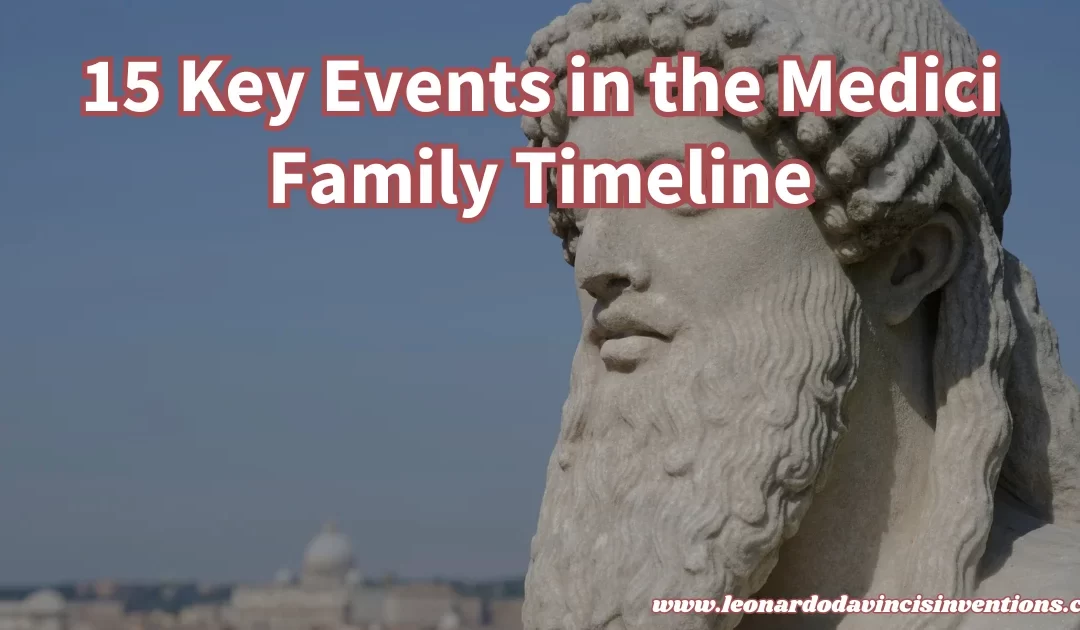
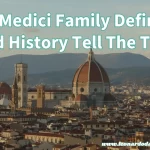
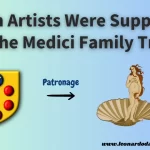
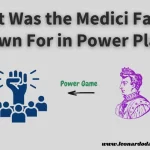
 Leonardo Bianchi,
the creator of Leonardo da Vinci's Inventions.
Thank you for visiting
Leonardo Bianchi,
the creator of Leonardo da Vinci's Inventions.
Thank you for visiting